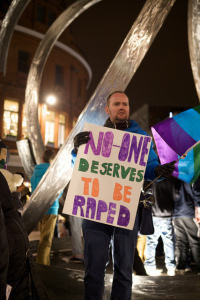Research overview of engaging men and boys

I’ve written a lot about the Lancet series on Violence Against Women and Girls already, but I also really want to highlight the piece they did on working with men and boys. The article by Jewkes, Flood, and Lang is a great introductory or background piece to engaging men and boys, because it talks about the historical context of involving men in prevention, about why we want to engage men and boys, and about what strategies and approaches we should use to try to engage men today.
The article starts with a history of men’s involvement in prevention. Understanding this historical context is crucial for being able to understand men’s current efforts to prevent violence against women and girls. After describing this context, the article goes on to give a lot of detail about what efforts to engage men and boys in prevention can and should look like. As the lessons from prevention told us, prevention work should focus on gendered power dynamics. This article gives us a good deal more information on how to do that. The main recommendation is to base efforts to engage men and boys in gender theory, both as an ideological foundation and as a guide for specific program objectives.
The ideas of gender theory that the article emphasizes are that gender is socially constructed, and that the dominant ideal of masculinity isn’t the only or the best kind of masculinity. The dominant ideal often involves men being tough and strong and having control and power over women, girls, and other men and boys. This connects to violence against women and girls because, “although not all men are violent, and some actively oppose violence, the use of violence over women is one source of power accorded to men in many settings.” People can be more or less able to live up to their view of gender ideals based on their socio-economic status, employment status, traumatic events, and other life circumstances. Finally, gender is relational, meaning that gender ideals, identity, and expression depend on other women and men’s expectations and approval.
Based on these ideas, the article suggests that the goals of prevention work with men and boys should be to transform gender ideals, expectations, and expression. The work should highlight variety in the kinds of masculinity that exist in a community, inconsistency in gender ideals, fluctuation of gender expression over time and in different circumstances, and similarities between men and women. It should also fight homophobia and reveal and challenge men’s privilege. These ideas challenge the dominant gender ideals and make room for individual men and boys to become more comfortable rejecting violent and controlling masculinity, and eventually collectively change gender norms in their community.
To me, the key is to not just talk about what masculinity is, why it’s connected to violence, and how it harms women, girls, men, and boys, but to figure out concrete ways to challenge men’s privilege, change what masculinity means, and create space for more variety in gender expression. A lot of programs do a good job of accomplishing these goals for individuals, but it’s harder to translate those changes to entire communities and societies. How does your work with men affect these higher levels? How can we make more community and societal change in gender expectations and ideals?
You can read the entire article for free at the link below. Just create a free username, and you’ll be granted access.
Full citation: Jewkes, R., Flood, M., & Lang, J. (2014). From work with men and boys to changes of social norms and reduction of inequities in gender relations: A conceptual shift in prevention of violence against women and girls. Lancet. Advance online publication. doi: 10.1016/S0140-6736(14)61683-4
Link: http://www.thelancet.com/journals/lancet/article/PIIS0140-6736(14)61683-4/fulltext
Full abstract:
“Violence perpetrated by and against men and boys is a major public health problem. Although individual men’s use of violence differs, engagement of all men and boys in action to prevent violence against women and girls is essential. We discuss why this engagement approach is theoretically important and how prevention interventions have developed from treating men simply as perpetrators of violence against women and girls or as allies of women in its prevention, to approaches that seek to transform the relations, social norms, and systems that sustain gender inequality and violence. We review evidence of intervention effectiveness in the reduction of violence or its risk factors, features commonly seen in more effective interventions, and how strong evidence-based interventions can be developed with more robust use of theory. Future interventions should emphasise work with both men and boys and women and girls to change social norms on gender relations, and need to appropriately accommodate the differences between men and women in the design of programmes.”

Deena, thanks for this. I’m delighted that you found the piece useful. People can find more of my writings and publications here: http://www.xyonline.net/category/authors/michael-flood.
Regards,
Michael Flood.